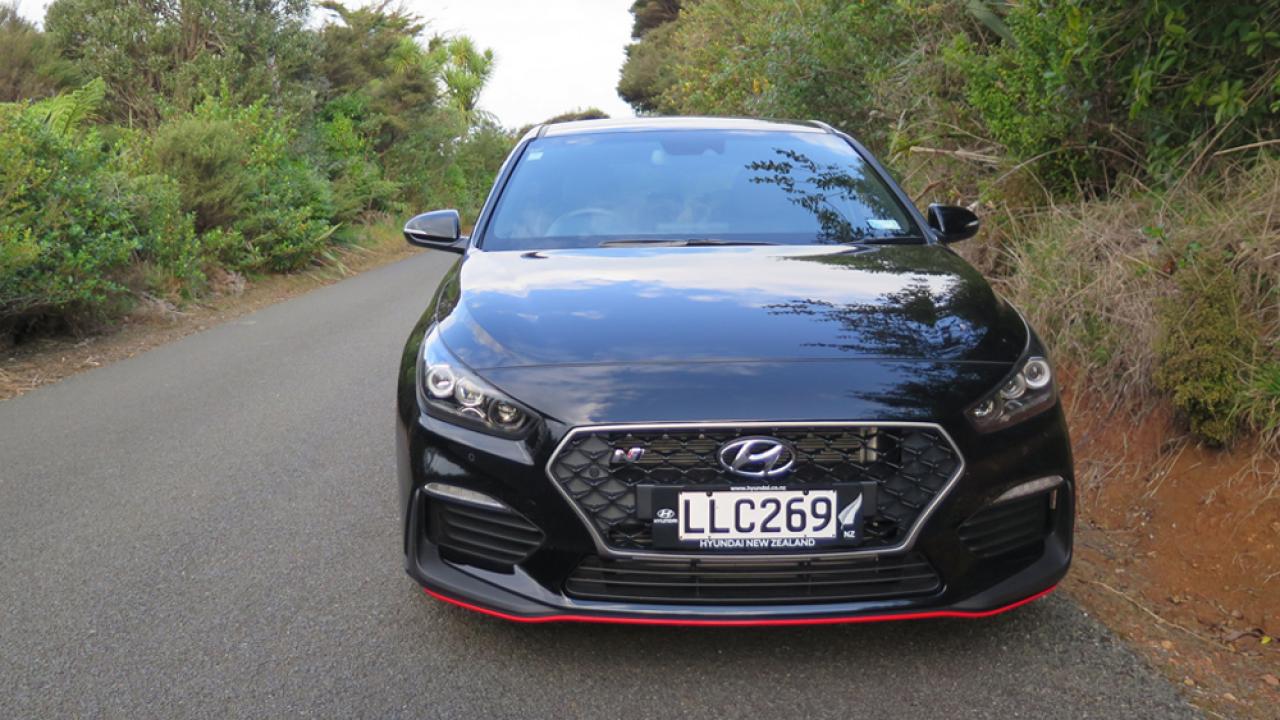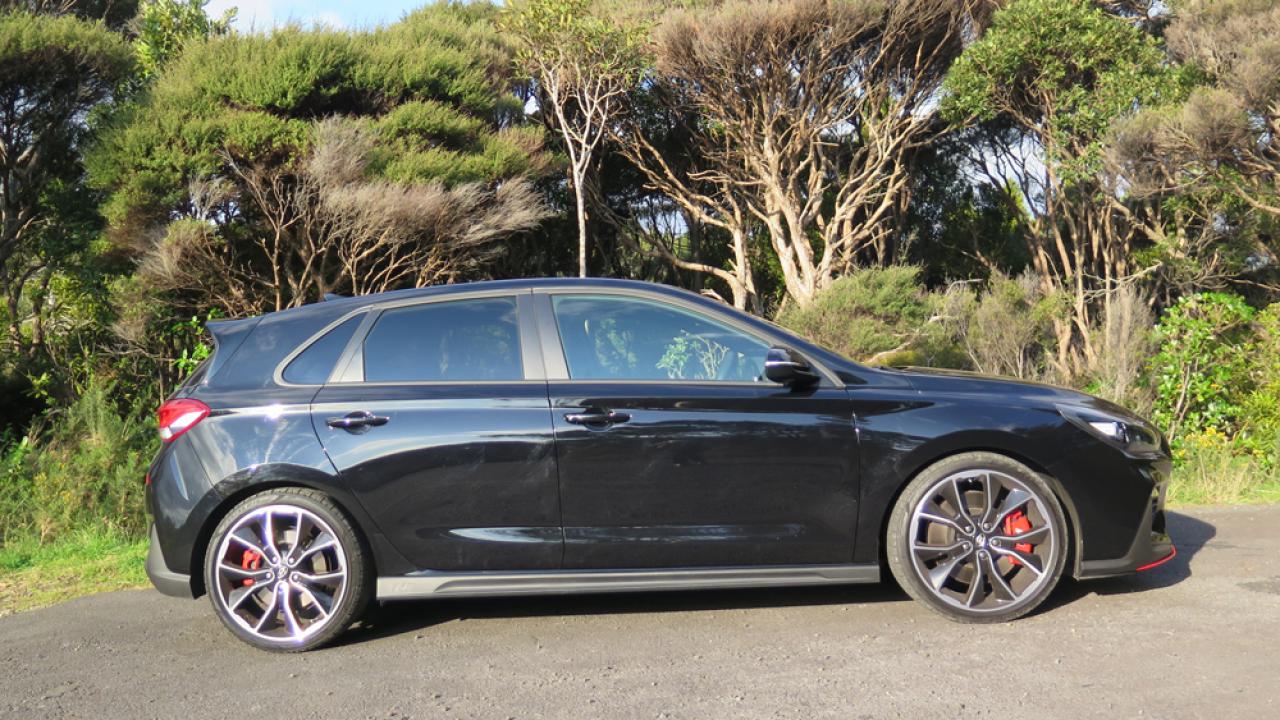If you’re thinking of Hyundai as a Korean Toyota – reliable and sensible, but rarely exciting – think again, for it’s just launched the first car from its sporty N sub-brand – yep, the N already seen on i20 WRC rally cars like that driven by Kiwi Hayden Paddon.
The letter ‘N’ allegedly stands for Namyang – the R&D centre that spawned this hot hatch – and Nürburgring, site of Hyundai’s European test centre, also involved in its testing and development.
Yes, this car is based on the i30N hatch, but it sits 8mm lower, wears a subtle body kit emphasized by touches of red, and includes a fair bit of other sporting equipment, such as electronically controlled suspension, 18-inch ventilated front and 17-inch rear brakes mounted into 19-inch wheels wrapped in low-profile Pirelli P-Zero 235/35 tyres, plus a manually operated hand brake, a Torque Vectoring System, and Drive Mode buttons mounted on the steering wheel that let you access and customize your engine and suspension settings, and even throttle response. We don’t recommend you switch the stability control off entirely, though you can do that too. The engine, suspension and transmission are set up for this car, which also features an electronically controlled limited slip diff, plus more visibly, items like those leather and suede front seats, and a bespoke instrument cluster.
But wait, there’s more – like launch control, reinforced front suspension, a stronger front subframe, and even a rear stiffness bar visible when you open the tailgate.
Hyundai topped all that off with our fave, the active variable exhaust system which emits playful pops and crackles from the muffler when in Sport or Custom modes.
Of course the car’s look has already made a few promises even before you slip into those supportive sport seats and start scrolling through what that touchscreen offers, including a lap timer, acceleration timer, and a torque, turbo boost and g force display, all hints that the claimed fuel consumption may be on the low side for any driver who is likely to play with all this stuff.
Not that you have to. Sure, the suspension isn’t as compliant as a standard i30, but you can still womble through an ordinary day’s humdrum tasks in the same way you would in a standard i30, albeit while accompanied by a racier aura. And you can also dispatch zero to 100kph in a claimed 6.1 seconds – not bad for a car at this price, but that’s unlikely to be why you’ll buy it. It’ll be in part for this engine, which sounds fabulously naughty at times, and is happy to drop power with a turbo surge which some will love, even while others would prefer a more linear response.
The character of that delivery really suits a bendy NZ back road, where the whole plot really comes together, the torque hauling you out of corners, the chassis nicely balanced, the six-speed box slick and easy to use and the brakes delivering just the right amount of power and feedback. True, the steering feels almost a touch under-assisted at times, just a little too muscular, but that’s now refreshing in an automotive world where electronic over-assistance seems the norm.
Our tester found the Normal mode actually the most engaging, with lots of grip, decent body control, ride that works on NZ roads and nice cornering balance. Sportier modes compromise ride in a way which doesn’t quite work on the lumps and bumps of real-world tarmac – though we’d imagine it could be great, given a race driver on a track. Otherwise, enjoy the fact you can tap into those modes – without feeling the need to.
Certainly your fuel budget will thank you if you don’t. Drive this car sportingly and you’ll never see anything remotely near the claimed 8.0l/100km – our tester hovered just under 11 for much of the test period. But with the trip zeroed, then 50km dispatched over a mix of hills, urban, semi-urban and highway driven at the speed of everyday commuting traffic, we used just under 9l/100km, this very unscientific test suggesting that those who rarely put the throttle to the floor shouldn’t have much to complain about at the pump, or anywhere else.
For this i30N gets plenty of the expected standard features, plus some: it doesn’t just have heated seats, for example, but a heated steering wheel as well. We guess the theory is to stave off numb fingers when flinging this little number about those frozen rally roads…
So yes, the I30N is impressive – though not perfect. The cabin is a little too ordinary for a car like this, and several likely hot-hatch competitors beat it in terms of on-paper numbers. But it certainly delivers grin factor in spades – and equally certainly it’s worth what Hyundai is charging.
Were it really a boy racer car we suspect the first aid kit might come in handy. In fact, at $54,990 it will be out of those boys (and girls) price range, and instead is likely to be bought by keen drivers who’ll use it as a useful family hatch most days, albeit one with distinctive flair. But come Sunday, and over a bendy road…
|
At a glance |
|
|
Models |
Hyundai i30N |
|
Engine |
2.0-litre 16-valve turbo |
|
Price |
$54,990 |
|
ANCAP safety rating |
Not yet tested |
|
Power and Torque |
202kW at 6000rpm, 353Nm from 1500 to 4700rpm (378Nm on overboost) |
|
Transmission |
Six-speed manual with rev-matching function |
|
Fuel economy |
8.0l/100km |
|
Towing capacity |
No tow rating |
|
2WD/4WD/AWD |
2WD front |
|
Seating capacity |
5 |
|
Luggage capacity/payload |
381/1287 litres |
Safety systems
- 7-Airbags
- Lane Keep Assist
- Autonomous Emergency Braking
- Auto headlights
- Rain sensing wipers
- Reversing camera with front and rear park assist
- Tyre pressure monitoring system






